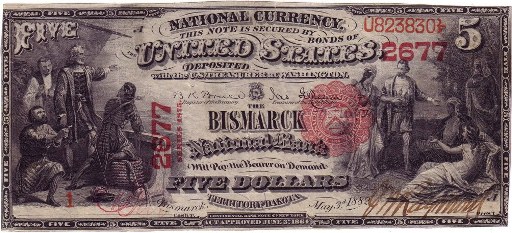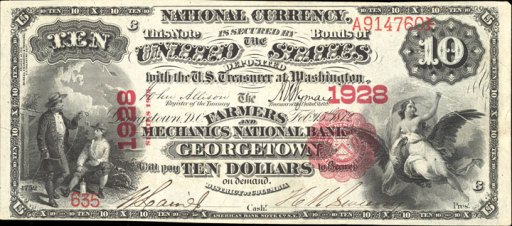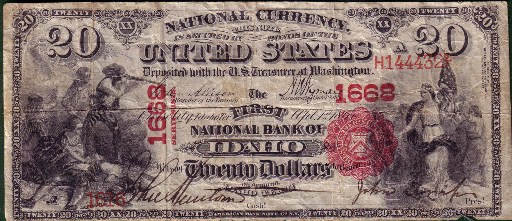The First National Bank Of Fargo
The First National Bank Of Fargo in North Dakota printed $2,589,070 dollars worth of national currency. Over $1,000,000 face value is a lot of money. However, some types and denominations of currency from this bank could still be rare. This national bank opened in 1878 and stopped printing money in 1935, which equals a 58 year printing period. That is considering a long operation period for a national bank. During its life, The First National Bank Of Fargo issued 17 different types and denominations of national currency. We have examples of the types listed below. Your bank note should look similar. Just the bank name will be different. For the record, The First National Bank Of Fargo was located in Cass County. It was assigned charter number 2377.
We buy all national currency. Please call or email us for a quote. Sales@AntiqueMoney.com
The First National Bank Of Fargo in North Dakota issued 2,925 sheets of $5 series of 1875 territorial national bank notes. Many territorial banks had outputs in the 2,000 to 4,000 range. Most first charter five dollar territorials that we encounter today are from the series of 1875. Despite saying series of 1875, these were actually printed as late as 1901 by a handful of banks. So while these might appear ancient, some are much newer than the series date would suggest. With that said, these are still rare items treasured by collectors. Exactly 42 national banks printed series of 1875 five dollar territorials. That list of banks pretty much included all of the territories from Arizona to Wyoming. Please give us a chance to help you establish the value of your note. You will likely be pleasantly surprised with how these bank notes are valued in today’s market.
Series of 1875 $5 Territorial National Bank Note
The First National Bank Of Fargo printed 1,200 sheets of $10 series of 1875 territorial national bank notes. A total sheet output in the lows 1,000s is a great sign that you own a very rare bank note. Thirty-two different banks printed series of 1875 $10 territorial bank notes. There is a nice mix of notes from states like North Dakota and some Western states as well. Prices for these range from high four figures to low five figures. Of course condition, bank, or serial number rarities could command more money. This is often the first type of bank note issued by pioneer banks in very remote areas. The survival number currently stands at 16 examples, but we usually handle a new discovery at least once a year, so that number is slowly rising, but this will never been a common bank note.
Series of 1875 $10 Territorial National Bank Note
The First National Bank Of Fargo also printed 1,200 sheets of $20 series of 1875 territorial national bank notes. Don’t get too caught up on the number of sheets printed. Twenty dollar series of 1875 territorial bank notes are very rare. They were only printed by 28 banks and only six unique notes are known to exist to collectors. This is the rarest denomination (below $50) for first charter territorials.
Series of 1875 $20 Territorial National Bank Note
The First National Bank Of Fargo also printed 4,407 sheets of $5 series of 1875 national bank notes. Hundreds of banks had sheet outputs between 2,500 and 5,000. That is pretty typical for a medium sized national bank in the 1870s. Series of 1875 $5 bills are some of the most commonly encountered bank notes from the first charter series. Only the original series $1 bill is more available. Some banks exclusively issued five dollar bills. So if you want an example from one of those banks then you don’t have many options. These notes have a rounded red seal and red serial numbers. They also all have a red charter number.
Series of 1875 $5 National Bank Note
The First National Bank Of Fargo also printed 2,128 sheets of $10 series of 1875 national bank notes. Any time you see a print range between 1,000 and 2,500 you can assume that the bank was small and that their notes could be fairly scarce. The two vignettes seen on 1875 $10 bank notes are “Franklin and Electricity” and “America Seizing Lightning”. These notes occasionally confuse novices because the year 1752 is printed on them. That is when Benjamin Franklin discovered electricity. It has nothing to do with when these bank notes were issued. The back of each $10 bill has “DeSoto Discovering the Mississippi.”
Series of 1875 $10 National Bank Note
The First National Bank Of Fargo also printed 2,128 sheets of $20 series of 1875 national bank notes. The exact number of series of 1875 $20 national bank notes printed by this bank is good to know. Don’t expect a high number to lower the value or a small number to increase the value. These notes are scarce enough on their own that the stats don’t really matter. Twenty dollars was a lot of money between 1875 and 1901, which is the time period in which these were printed. These just weren’t saved in high numbers.
Series of 1875 $20 National Bank Note
The First National Bank Of Fargo also printed 10,400 sheets of $5 1882 brown back national bank notes. When we start talking about a printing number in the five figure range, then you are likely not dealing with a great rarity. However, the note could certainly still be popular and valuable. You can take the total number of sheets printed and multiply that number by four to get the exact number of 1882 $5 brown back bank notes this bank issued. Each note has a portrait of James Garfield on the left hand side of the bill. These are very popular with collectors because they have different text layouts. Some notes are worth as little as a few hundred dollars, but most are worth a good deal more.
Series of 1882 $5 Brown Back
The First National Bank Of Fargo also printed 8,140 sheets of $10 1882 brown back national bank notes. A print range between 5,000 and 10,000 suggests that there should be at least a couple of notes known to exist. There were three $10 bills printed on a single sheet of 1882 brown backs. The design of the bill is similar to all earlier ten dollar national bank notes. The nickname comes from the fact that these bills have a brown seal and brown overprint. Despite saying series of 1882, these were actually printed by some banks up until 1908. The date you see in cursive relates to when the bank first started issuing brown back notes.
Series of 1882 $10 Brown Back
The First National Bank Of Fargo also printed 8,140 sheets of $20 1882 brown back national bank notes. As you can see, the sheet output is the same for $20 brown backs as it is for $10 brown backs. There was only one $20 brown back printed on a sheet. So the sheet output also equals the total note output. One neat thing about all brown backs is that they each have a different back design based on which state issued them. The back left hand side of the note shows the state seal of which ever state the national bank was located in. Generally speaking, 1882 $20 brown backs are pretty difficult to locate. They typically were printed in small numbers and they don’t have a great survival rate.
Series of 1882 $20 Brown Back
The First National Bank Of Fargo also printed 12,154 sheets of $5 1882 blue seal national bank notes. These were only issued by banks for about ten years (at the most). So it is unusual to see such a high sheet output. This will likely be a common issue unless it is rare signature combination variety. 1882 $5 blue seal bank notes were issued by some national banks in The United States. While these are a somewhat rarer issue, they just aren’t especially popular with collectors. With exception of some minor differences, they look exactly like the earlier brown back series. Most collectors would prefer the brown back notes. With that said, some 1882 blue seals can still be worth thousands of dollars. So don’t just assume that what you have is automatically common.
1882 Blue Seal $5 National Bank Note
The First National Bank Of Fargo also printed 8,661 sheets of $10 1882 blue seal national bank notes. That is a pretty standard sheet output number for these issues. Most of the value is going to be in the condition. All of these notes say series of 1882 but they were actually printed between 1908 and 1921. So they aren’t quite as old as the dates might suggest. There is also a date on these notes that is between 1888 and 1901. That date is written in cursive text and it represents when the bank was chartered or re-chartered. Some of the so called 1882 value back notes have a chance to be really rare. Most of the earlier notes that say 1882-1908 on the back are likely going to be relatively common. The designs are exactly the same on the front. Each has a blue seal and charter number.
1882 Blue Seal $10 National Bank Note
The First National Bank Of Fargo also printed 8,661 sheets of $20 1882 blue seal national bank notes. That is the same number of sheets as the ten dollar denomination. You don’t have to multiply by three to get the exact number of notes issued though. There was only one twenty dollar bill per sheet. As with any national bank note, the exact value is still based on the condition, serial number, and bank of issue.
1882 Blue Seal $20 National Bank Note
The First National Bank Of Fargo also printed 12,775 sheets of $5 1902 blue seal national bank notes. Once a bank prints more than 10,000 sheets of blue seals it becomes very difficult for those notes to be rare. Ben Harrison is on the front of all 1902 $5 blue seal bank notes. This happens to be the smallest denomination issued for the 1902 series. Each note is complete with a blue seal and blue charter number. Despite saying series of 1902, these were actually issued by national banks between 1908 and 1928. There are two different types of blue seals. The first type is called a date back and it has “1902-1908” written on the back of the bill. The other type is called a plain back; it does not have the date stamps on the back of the bill. The values for these notes range widely based on condition and the bank of issue.
1902 $5 Blue Seal National Bank Note
The First National Bank Of Fargo also printed 7,208 sheets of $10 1902 blue seal national bank notes. That is a fairly standard sheet output for a national bank issuing blue seals. You likely aren’t dealing with a super common or a super rare bank note. 1902 $10 blue seal bank notes all have a portrait of William McKinley on them. Values can range from as little as $40 up to over $10,000. There really is no trick to know what is rare and what is common by just doing an internet search. You really need to work with an expert (like us) in order to determine the value of your specific bank note. There are at least ten different factors than can make some 1902 $10 blue seals worth more than others. We know exactly what to look for and we would be happy to provide a free appraisal and our best offer.
1902 $10 Blue Seal National Bank Note
The First National Bank Of Fargo also printed 7,208 sheets of $20 1902 blue seal national bank notes. The same rarity rules for 1902 $10 blue seals also apply to $20 blue seals. Just remember that $20 bills are by nature three times rarer (unfortunately they don’t command a premium over other denominations). Hugh McCulloch is pictured on the front of each bill. Contact us if you need pricing help.
1902 $20 Blue Seal National Bank Note
The First National Bank Of Fargo also printed 100 sheets of $50 1902 blue seal national bank notes. There is no trick to knowing which 1902 blue seals will be common and rare. Often times the number printed won’t tell you much information. The value still comes down to condition and demand. That is a surprise to most people. In fact, most 1902 $50 bills we see are worth between $750 and $1,250. The rarer ones can be worth more than $5,000. However, there isn’t much middle ground.
1902 $50 Blue Seal National Bank Note
The First National Bank Of Fargo also printed 100 sheets of $100 1902 blue seal national bank notes. It is no coincidence that the sheet numbers for $50 bills and $100 bills are the same. They were printed on the same sheets. Most $100 blue seals are at least scarce; others can be very rare. John J Knox is printed on the front of each bill. Most collectors like the back design a lot more though. It is really unique and different from most other national bank notes. Prices for 1902 $100 blue seals are pretty similar to $50 blue seals. They are both equally common or equally rare, depending on how you look at it.
1902 $100 Blue Seal National Bank Note



